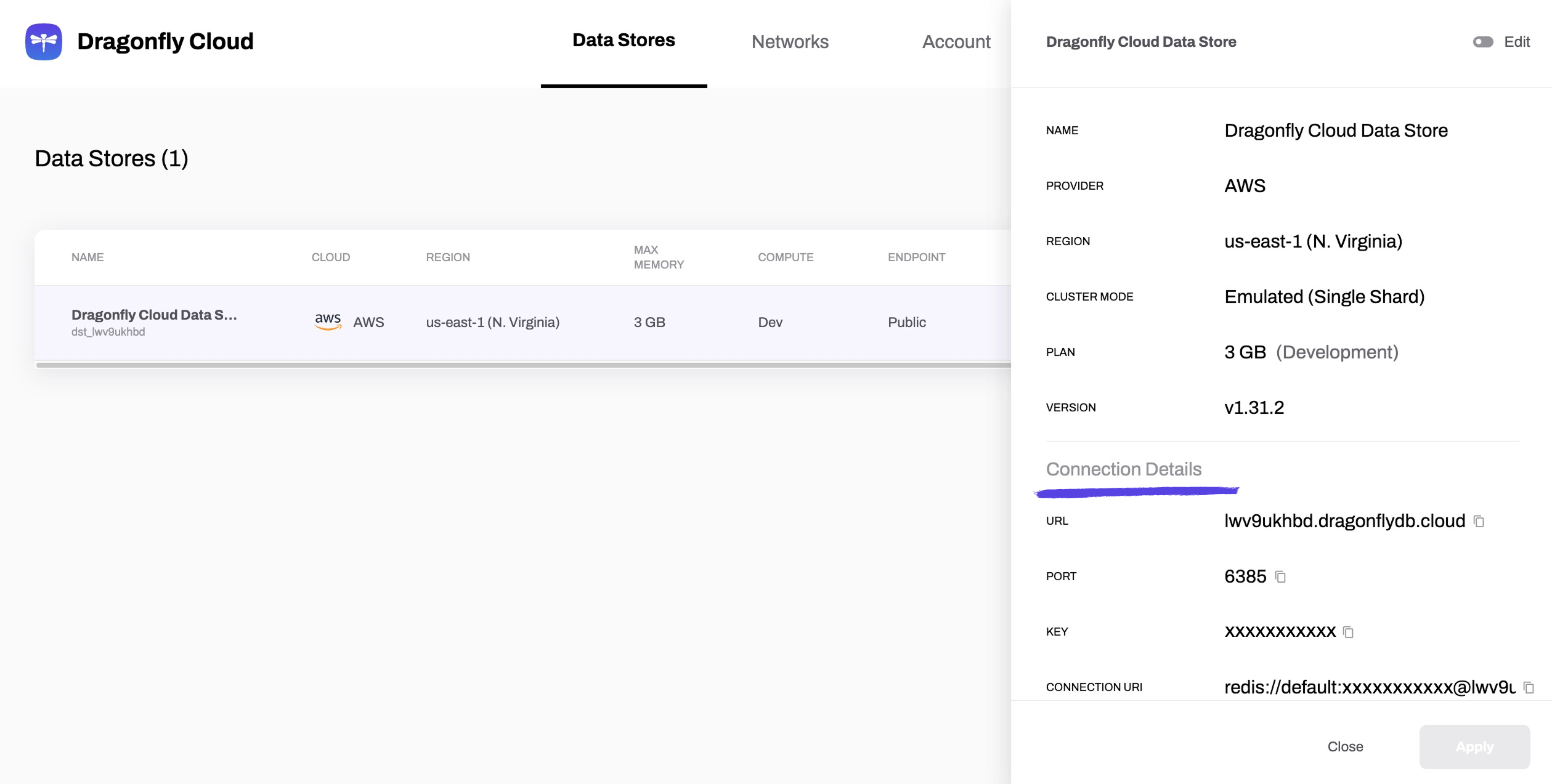Redis Clients
CLOUDOnce a data store's Status is Active, you can connect to it with any Redis client by following the Connection Details section in the data store details drawer. Here are a few popular client libraries and code snippets to connect to the data store.

Notes:
- Unless otherwise specified, you should use the connection details found for each data store
to replace those placeholders in the code snippets below, where we use public endpoints with the
defaultuser and TLS disabled. - For production, we strongly recommend using private networks and connections.
Redis CLI
Single-Shard Data Store
- Install
redis-cli. - With the Connection URI from the data store drawer, run
redis-cliin the terminal:
$> redis-cli -u <CONNECTION_URI> PING
Dragonfly Swarm
- If you are running a Dragonfly Swarm multi-shard cluster in Dragonfly Cloud, make sure to use the cluster-aware flag:
# The '-c' flag enables client-side cluster mode, which follows '-ASK' and '-MOVED' redirections.
$> redis-cli -c -u <CONNECTION_URI> PING
TypeScript & JavaScript
Single-Shard Data Store
- Install the
ioredispackage. - Use the following code snippet to connect to the data store:
import { Redis as Dragonfly } from "ioredis";
// Connection details can be found in your Dragonfly Cloud console.
const client = new Dragonfly({
host: "<URL>",
port: 6385,
username: "default",
password: "<KEY>",
});
client.ping().then((resp) => console.log(resp));
Dragonfly Swarm & Read Replicas
- While running a Dragonfly Swarm cluster, make sure to use the cluster-aware version of the client as shown below.
- If your application requires even higher read throughput and can tolerate slightly stale reads, you can use read replicas, which are enabled by default when deploying Dragonfly Swarm with replicas.
import { Redis as Dragonfly } from "ioredis";
// Connection details can be found in your Dragonfly Cloud console.
//
// For the 'scaleReads' option:
// - 'master': All queries, including reads, are sent to primary nodes.
// - 'all': Write to primary nodes, read from either primary nodes or replicas.
// - 'slave': Write to primary nodes, read from replicas exclusively.
import { Redis as Dragonfly } from "ioredis";
const client = new Dragonfly.Cluster([{ host: "<URL>", port: 6385 }], {
redisOptions: {
username: "default",
password: "<KEY>",
},
scaleReads: "slave",
});
client.ping().then((resp) => console.log(resp));
Python
Single-Shard Data Store
- Install the redis-py package.
- Use the following code snippet to connect to the data store:
import redis
# Connection details can be found in your Dragonfly Cloud console.
client = redis.Redis.from_url("<CONNECTION_URI>")
client.ping()
Dragonfly Swarm & Read Replicas
- While running a Dragonfly Swarm cluster, make sure to use the cluster-aware version of the client as shown below.
- If your application requires even higher read throughput and can tolerate slightly stale reads, you can use read replicas, which are enabled by default when deploying Dragonfly Swarm with replicas.
from redis import RedisCluster as DragonflySwarm
# Connection details can be found in your Dragonfly Cloud console.
client = DragonflySwarm(
host="<URL>",
port=6385,
username="default",
password="<KEY>",
read_from_replicas=True, # Enables read-only commands on replicas.
)
client.ping()
Go
Single-Shard Data Store
- Install the go-redis package.
- Use the following code snippet to connect to the data store:
package main
import (
"context"
"fmt"
"github.com/redis/go-redis/v9"
)
func main() {
// Connection details can be found in your Dragonfly Cloud console.
client := redis.NewClient(&redis.Options{
Addr: "<URL>:<PORT>",
Username: "default",
Password: "<KEY>",
})
pong, err := client.Ping(context.Background()).Result()
if err != nil {
fmt.Println(err)
}
fmt.Println(pong)
}
Dragonfly Swarm & Read Replicas
- While running a Dragonfly Swarm cluster, make sure to use the cluster-aware version of the client as shown below.
- If your application requires even higher read throughput and can tolerate slightly stale reads, you can use read replicas, which are enabled by default when deploying Dragonfly Swarm with replicas.
package main
import (
"context"
"fmt"
"github.com/redis/go-redis/v9"
)
func main() {
// Connection details can be found in your Dragonfly Cloud console.
client := redis.NewClusterClient(
&redis.ClusterOptions{
Addrs: []string{
"<URL>:<PORT>",
},
Username: "default",
Password: "<KEY>",
ReadOnly: true, // Enables read-only commands on replicas.
},
)
pong, err := client.Ping(context.Background()).Result()
if err != nil {
fmt.Println(err)
}
fmt.Println(pong)
}